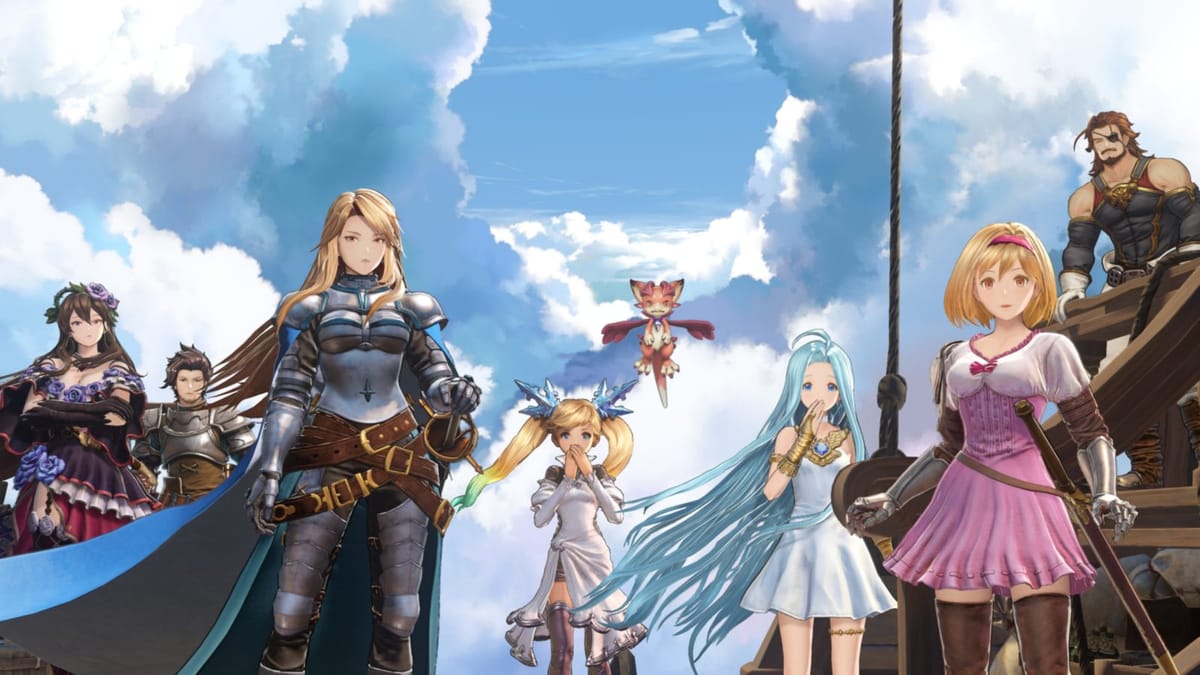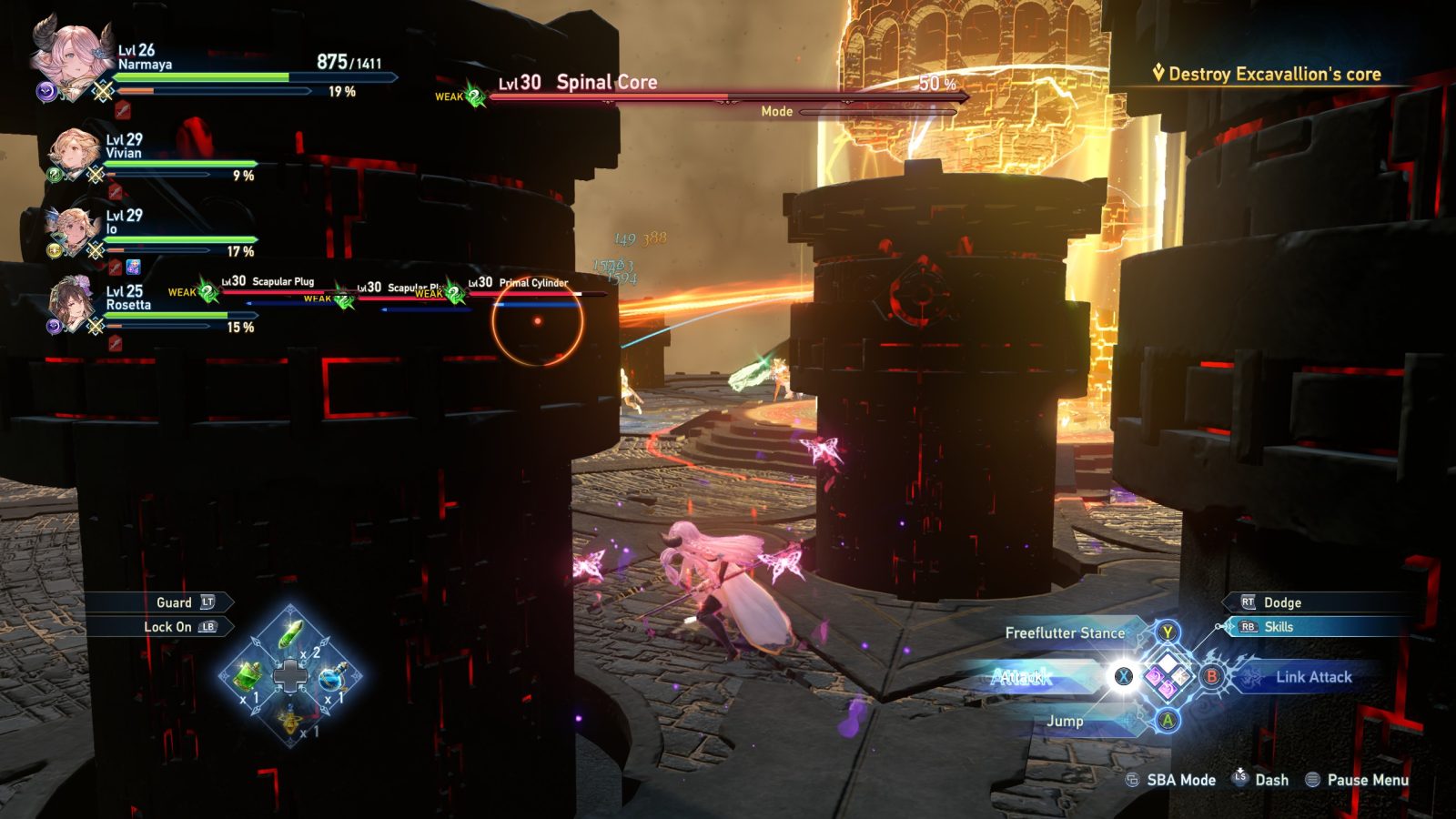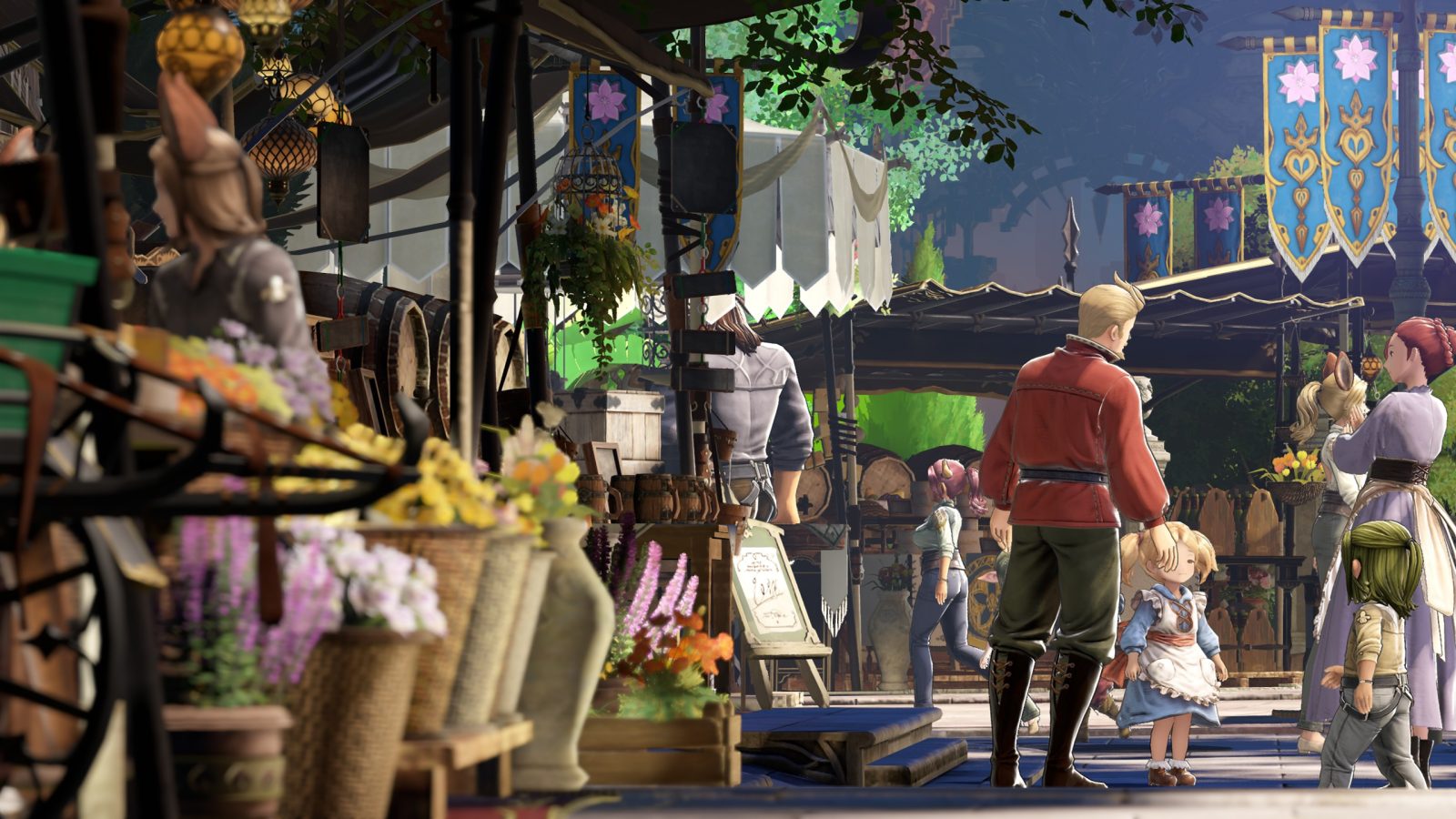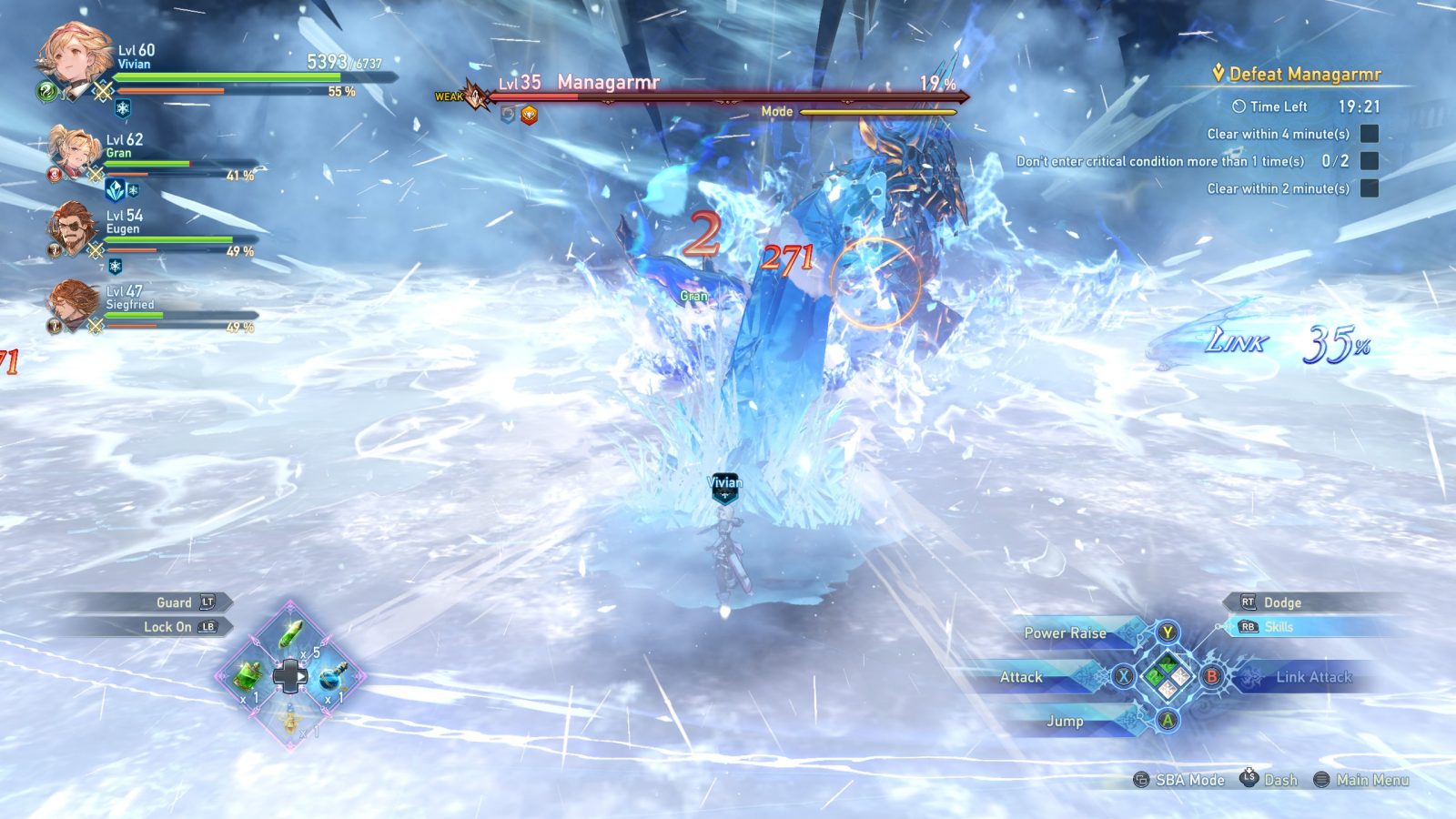
On the journey to Estalucia, the crew of the Grancypher enters the Skydom of Zegagrande. Here, the sky dwellers worship primal beasts as gods, with the religious Avia group sowing fear throughout the land in the name of their faith. When their leader, Lilith, kidnaps Lyria, the captain of the Grancypher and her crew must fight across the skies to rescue her, before she’s lost forever.
Granblue Fantasy is a remarkably versatile franchise. What started as a mobile game eventually spun off into an anime series, two fighting games, and now an action RPG in the form of Granblue Fantasy: Relink. Despite the shifts in genre and medium, Cygames hasn’t lost a beat in translating their world, characters, and even gameplay systems. No matter where you start, Granblue is instantly captivating, and Relink continues this trend.
Relink’s story starts out with very low stakes, but eventually grows to your typical save the world plot. That’s not a bad thing and we were invested throughout, but it does feel like it’s missing something. This could be due to the game’s structure, which is very similar to Granblue Fantasy Versus. Each chapter sees the crew sailing through the skies to another island of Zegagrande, tackling a usually linear dungeon with a few bosses along the way, ending with a bigger and more complex boss encounter. Then you’re sent back to one of the two hub towns to upgrade your gear and characters to prepare for the next chapter. It’s expedient and no nonsense, but we like these characters a lot and would have enjoyed some downtime to just hang out with them.
The characters converse constantly throughout each story chapter which is incredibly charming, but unlockable characters will only very rarely join in. This means your mostly silent protagonist (Gran or Djeeta), Katalina, Rackam, Io, Vyrn, and Rosetta are the only voices you’ll be hearing throughout. Having only played the fighting games and the opening of the mobile game, I know very little about Rosetta in particular. The game expects a baseline amount of familiarity with its characters and setting, and if you’re not you can read up in Lyria’s Journal or open the glossary at any time during most cutscenes.

The Fate Episodes also serve as a bit of catch-up and give you the gist of each character’s personality. Every character, including those you unlock, has 10 Fate Episodes you can view at the quest counter. The majority of these are visual novel-like cutscenes with a static image in the background as voiced text crawls by. To be honest, these aren’t particularly interesting and each character’s story could have been conveyed in more interesting ways. These do give the character in question significant stat boosts and upgrades upon completion, however, so they are essentially required unless you want to be dying constantly.
Two of these 10 episodes for each character is actually a quest, requiring you to play as them, and these are a lot more interesting. You get the usual banter throughout, but this time actually including unlockable characters and deals with whatever is going on in their side story. These quests are much better at getting you invested in the character and what’s going on, and I was actually compelled to pay attention to the visual novel scenes afterwards to see the conclusion. These only begin at Episode 4 though, and could have been used very effectively as the prologue for each story. Some Tales of type skit scenes would have gone a long way towards getting players more familiar and invested in the core cast at the very least.

OK, we’ve gone on long enough about our issues with the story. While that’s a big part of the game, Relink is still a fantastic action game at its core and that gameplay is really the focus here. Every character has a different gimmick and playstyle. The Captain (who is renamable and lacks any personality, but I digress) has a lengthy combo they can perform by mashing X, and at any time during the combo you can press Y for a different finisher. After performing a finisher, you can then unleash their charge move with Y again with a much shorter charge time. Zeta, meanwhile, has a parry move on Y while her X combo will eventually launch her into the air to repeatedly dive at the enemy as long as you can press X with good timing. Narmaya can swap between two different sword stances by pressing Y, one being slow and powerful while the other is fast and weaker. At the end of each X combo, you can instantly swap stances and continue the combo by pressing Y with good timing. I could go on, but while the game is very mashy every character feels completely unique and you’ll get a lot more out of combat if you can utilize their strengths to the fullest.
Each playable character has an element associated with them, either light, dark, fire, ice, earth, and wind. They’ll deal more damage when attacking an enemy their element is weak to, but not too much less otherwise. You can set up a party of 4 in the menu for different situations, but the captain must be in the party for the main story. You can play with your favorites or mix it up to hit weaknesses. Regardless, you’ll be controlling the character in the leftmost slot and you cannot switch mid-combat unfortunately.
During a battle, every party member builds up a Skybound Art, or SBA. Once it’s full, you can unleash a devastating attack by pressing in both sticks. This will start a chain attack, with other party members following up with their SBAs. If all four party members land the attack, you’ll deal even more damage with a Full Burst. The burst will be the element of whoever started the chain, so it’s important to plan out SBA usage. It’ll still deal massive damage regardless, and the AI, while normally smart, won’t take advantage of weaknesses in this way.
As you fight and level up, you’ll earn materials, Sigils, and Mastery Points. Materials are used to upgrade and forge new weapons, while Sigils are equippable stat buffs. These are barely noticeable boosts to attack, defense, and other stats, but some are a bit more interesting like increasing the amount of potions you can hold. Mastery Points, meanwhile, are shared between all characters. You can spend them in a character’s skill tree to unlock stat bonus, the perfect dodge and perfect block, and new abilities used in battle by pressing RB and the corresponding face button. These trees are strictly linear, so there’s no real character building. It’s also best to pick a few characters and focus on leveling them up so there are enough points to go around.

Whaling on an enemy will build up a small meter which, when filled, will trigger a Link attack. You press the B button to participate in one, and it’ll usually jump you right to where the target is for an attack. The more party members participate in a link, the more the Link percentage points you gain, seen on the right side of the screen. Once this reaches 100% and all four party members perform a Link, enemies will slow down for a time and the entire party will receive various buffs.
The combat is incredibly hectic but a ton of fun. You can play on easy and mash your way through, engage a bit more on normal, or utilize most of the systems (except for Sigils) on Hard, which is what I played on. Nailing that perfect dodge or setting things up for a Full Chain kill is incredibly satisfying, and it gets even more fun when you’re playing with real people. Being pre-release, we weren’t able to get a full party together, but Anthony and I with two CPUs had a blast. He stuck with Zeta while I hopped around a few characters, the Captain is my go-to though. It’s a bit like Monster Hunter crossed with Final Fantasy XIV. You choose a quest from the hub, dodge attacks and floor AOEs, then you’re graded, rewarded accordingly, and begin the loop again.

Unfortunately, you cannot play through the story together. Even after beating the game and unlocking chapter replay, the option is grayed out when in a multiplayer lobby. It’s a disappointment, but the meat of the game does lie in these side quests after clearing the main story. Before then, you only have access to easy and normal rank quests, but seeing credits will unlock hard quests. After completing several hard quests, you can then unlock very hard rank. You’ll be ready for hard after going through the story, but very hard will require a lot more prep to stand a real chance against. It’s clear Cygames wants Relink to be active for quite a while after release, and while some systems and storytelling devices don’t quite work out, I think it is fun enough to have quite a legacy.
Lastly, let’s touch on PC visuals and performance. The game is absolutely gorgeous, with the mobile game’s art style translating perfectly into full 3D. Characters have this 2D-style hatching on them to simulate shading, there are tons of particle effects in combat, and environments are varied and intricately detailed. On an RTX 4070 at the highest settings in 1440p, the game reached 120 fps with no noticeable drops even in intense combat segments. There’s no DLSS or upscaling of any kind and graphics options are very limited, so you will need some power in your rig to run the game properly.

On Steam Deck, the game would struggle to reach 60 in any scenario, so I capped that at 30 and cranked the graphics to Ultra as that seemed to make no difference in performance or battery life. The device will still get pretty hot and only last about an hour, but it’s a great option to do a few quests when you’re away from the PC.
If you’re looking to play with a keyboard and mouse, however, Relink is greatly laking in that regard. The default controls are oddly laid out, with it being especially difficult to use any skills if you don’t have at least four number buttons on your mouse. There’s also no mouse support for menus, so you have to navigate entirely with the keyboard. It is fully customizable though, so you may get better results after tweaking. I do wish this rebindabiltiy extended to the controller, though that is still the best way to play out of the box.
Granblue Fantasy Relink
Great
Granblue Fantasy: Relink is yet another bold leap for the franchise and it lands gracefully. The combat is a ton of fun with a massive and unique roster of characters. The game could have introduced characters much better and given them more quiet moments, but the story is nice to watch play out, and it all leads into a massive post-game that will keep you playing for a long time.
Pros
- Amazing visuals
- Incredibly fun and hectic combat
- Good story
Cons
- Poor introduction to characters
- Sigils make little impact
- Story goes a bit too fast
